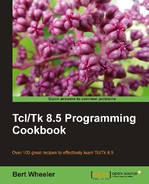Created in 1988 by John Ousterhoult, while working at the University of Califormia, Berkeley, Tcl (Tool Command Language) is a scripting language originally designed for embedded system platforms. Since its creation, Tcl has grown far beyond its original design with numerous expansions and additions (such as the graphical Took Kit or Tk) to become a full-featured scripted programming language capable of creating elegant, cross-platform solutions.
This book is written for both the beginning developer looking for a instructions on how to get their application up and running quickly to the experienced Tcl/Tk programmer looking to sharpen their skills. You will find everything from utilization of the console commands through to the creation of a stand-alone application.
Chapter 1, The Tcl Shell, gives an introduction to the Tcl shell.
Chapter 2, Using the Building Blocks Control Constructs, talks about using control constructs (if statements, for statements, and so on) to perform control program flow.
Chapter 3, Error Handling, talks about using the built-in commands and the Tcl shell to perform error handling.
Chapter 4, Handling String Expressions, explains how to create, manipulate, and manage string variables.
Chapter 5, Expanding String Functionality Using List, shows how to create, manipulate, and manage data in Tcl lists.
Chapter 6, The Tcl Dictionary, explains how to create, manipulate, and manage data in Tcl dictionaries.
Chapter 7, File Operations, tells how to open, read, write, and configure access to files stored on the system.
Chapter 8, Tk GUI Programming with Tcl/Tk, gives an introduction to the Tk shell, creating and managing a widget or window.
Chapter 9, Configuring and Controlling Tk Widgets, explains about creating and managing the most commonly used Tk widgets.
Chapter 10, Geometry Management, talks about managing the layout and design of the window.
Chapter 11, Using Tcl Built-In Dialog Windows, is about the creation and use of the Tcl built-in dialog windows available in Tk.
Chapter 12, Creating and Managing Menus, explains creating and managing menus, menu buttons, and pop-up menus.
Chapter 13, Creating the Address Book Application, gives full code listing and description of an Address Book application that makes use of the information covered in the previous sections.
